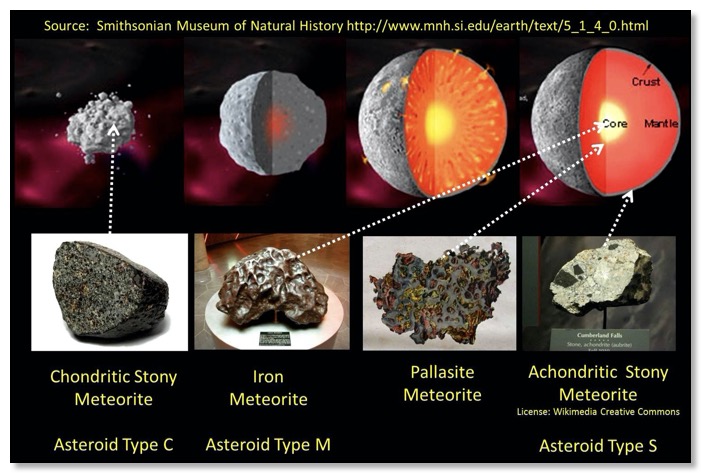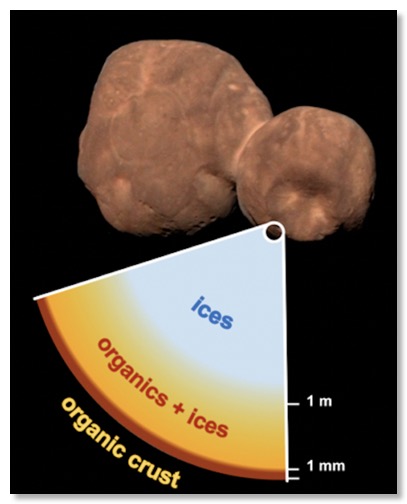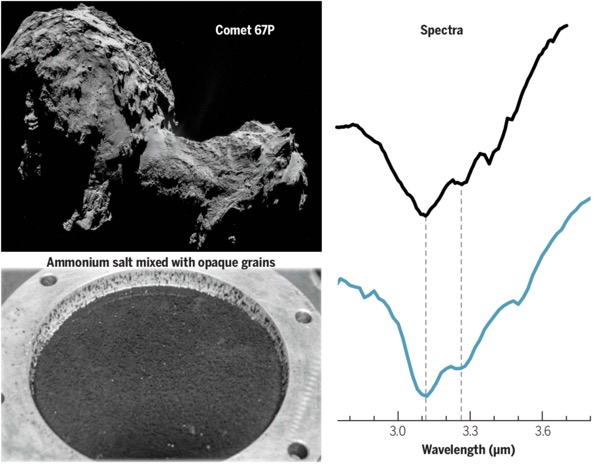Research streams
My research activities focus on the formation of the Solar System, and in particular on the early phases during which small bodies and dwarf planets were formed. Two approaches prevail to explore this theme:
- (1) remote observation of young planetary systems in formation, dense cores, proto-stellar envelopes, class I and II disks and debris disks, and the chemical and dynamic modeling of these environments;
- (2) the study of the chemical composition and dynamic properties of small objects in the solar system (small bodies, dwarf planets, irregular satellites).
These two approaches are complementary. However, the observables produced by the study of small objects in the solar system present an unrivaled level of relevance and precision in terms of chronology and chemical composition of solid materials. This contribution is made possible by the laboratory study of meteorites and samples collected on the surface of planetary bodies, as well as by analyzes carried out in-situ by spacecrafts (e.g. Near, Stardust, Hayabusa & Hayabusa 2 space missions, Rosetta, Osiris Rex, New Horizons).
 Left: Ordinary chondrites, showing different phases (chondrtles, matrix) that were present in the inner region of the protosolar disk. Right: determination of the age of CAIs in Allende (CV3).
Left: Ordinary chondrites, showing different phases (chondrtles, matrix) that were present in the inner region of the protosolar disk. Right: determination of the age of CAIs in Allende (CV3).Small (undifferentiated) bodies, and to a lesser degree dwarf planets, have largely escaped planetary evolution and preserve refractory and volatile constituents which were present at their place of accretion. Unfortunately, all these objects, including those preserved in very cold conditions at large heliocentric distances, were the subject of so-called post-accretional processes, which could modify, all or part, the phases present. Understanding the nature and impact of these processes is a fundamental step in interpreting the composition of these objects with a view to going back to primordial pre-accretional information, and in particular to constraining the chemistry of the volatile elements in the proto-disk. solar and the contribution of the pre-solar heritage.
 Illustration of the effet of thermal metamorphism: increasing grade until planetary differentiation. The main chondrite groups reflect this process.
Illustration of the effet of thermal metamorphism: increasing grade until planetary differentiation. The main chondrite groups reflect this process. Formation of a red organic crust from methanol ice radiolysis under conditions of Arrokoth TNO.
Formation of a red organic crust from methanol ice radiolysis under conditions of Arrokoth TNO.My research activities focus more specifically on the following aspects:
- Study of organic matter in meteorites, interplanetary dust and samples collected by spacecrafts (Hayabusa 2)
- Post-accretional processes in meteorites and TNOs
- Remote-sensing of planetary bodies in the visible-infrared range, collected from the ground and by space missions (Rosetta, New Horizons, Juice)
- The study of the optical properties of planetary materials in the laboratory, and the synthesis of model materials
- Experimental simulations of physico-chemical processes involved in the subsurface and surface of planetary bodies, as well as in the proto-solar disk.

Identification of ammonium salts at the surface of comet 67P/CG (VIRTIS/Rosetta data) (Poch et al., 2020). Left: Comet 6P and analog materials of the cometary crust after water ice sublimation. Right: comparison of the spectrum of 67P with the experimental spectrum of the analog.
 (a): Spectral slope S vs. Geometric albedo, identifying two main groups of TNOs (excluding dwarf planets) (Lacerda et al. 2014). (b) : Reflectance spectrum of the TNO Arrokoth, collected by MVIC/LEISA instruments aboard New Horizons (Stern et al., 2014). (c) : Artist figure representing the TNOs measured by the Herschel telescope (Credit : ESA/Herschel/PCAS/SPIRE). (d) : Photograph of TNO Arrokoth (Stern et al., 2014).
(a): Spectral slope S vs. Geometric albedo, identifying two main groups of TNOs (excluding dwarf planets) (Lacerda et al. 2014). (b) : Reflectance spectrum of the TNO Arrokoth, collected by MVIC/LEISA instruments aboard New Horizons (Stern et al., 2014). (c) : Artist figure representing the TNOs measured by the Herschel telescope (Credit : ESA/Herschel/PCAS/SPIRE). (d) : Photograph of TNO Arrokoth (Stern et al., 2014). Affiliations: Meteoritical Society; Geochemical Society; International Astronomical Union.
Equipements:
Visit : https://ipag.osug.fr/english/research/resources/equipments/
Our equipments also include a cryogenic experiment dedicated to investigating the spectral properties of ice and ice chemistry (Bruker VERTEX 70v spectrometer, vacuum chamber equipped with a cryocooler, KIMBALL electron gun, etc.).
